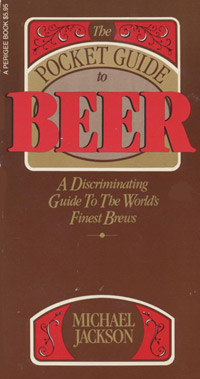 When somebody talks about “MJ’s list of best beers” do you think about the latest offering from Men’s Journal or one from Michael Jackson?
When somebody talks about “MJ’s list of best beers” do you think about the latest offering from Men’s Journal or one from Michael Jackson?
Me too.
Working on another project I recently hauled out his first Pocket Guide to Beer, published in 1982 and opened enough times since that the 18 pages containing Guinness through Anchor keep falling out.
This was the only pocket guide where Jackson used a 5-star rating. In following editions the highest was 4. In essence, each 5-star beer in this edition was a best of breed, so Zum Uerige Altbier represents that style, Westmalle Tripel that one, etc. (More about this at the bottom.)
Just for fun, here are the 42 beers that Jackson awarded 5 stars. (He also gave all 12 traditional Lambic brewers in the Senne Valley 5 stars “for dedication to an elusive craft,” adding “their products vary according to the good years and the bad, a greater discrimination would be illogical.”)
Czech Republic
Pilsner Urquell
Germany
Jever Pilsner
Einbecker Ur-Bock
Dortmunder Kronen Export
Zum Uerige Altbier
Kulminator 28 Urtyp Hell
Hofbräuhaus Maibock
Hofbräuhaus Edel-Weizen
Paulaner Urtyp
Paulaner Salvator
Schlenkerla Märzen
Spaten Dunkel Export
Spaten Ur-Märzen
Weihenstephan Weizenbock
Kindl Berliner Weisse
Belgium
Duvel
Liefmans Goudenband Speciaal Provisie
Rodenbach
Rodenbach Grand Cru
Westmalle Tripel
Hoegaards Wit
Saison Dupont
Chimay Red
Chimay Blue
Orval
Britain and Ireland
Brakspear’s Pale Ale
Courage Imperial Russian Stout
Fuller’s ESB
Gales Prize Old Ale
Whitbread Gold Label
Mackeson
Marston’s Pedigree
Marston’s Owd Roger
Highgate Mild
Thomas Hardy’s Ale
Belhaven 80/-
Traquair House
Guinness Extra Stout (Britain and Ireland)
Guinness Foreign Extra Stout
France
Jenlain
United States
Anchor Steam
Australia
Cooper’s Sparkling Ale
In the introduction Jackson explained a beer rated 5 stars was “a world classic either because it has outstanding complexity and distinction or because it is the definitive example of its style, and no matter whether everyone is capable of appreciating it; some people probably don’t like first-growth Bordeaux, either.”
In later editions he introduced the star ratings by making it clear they compared beers within a region to each other. For this first one, he wrote, “The whole scale of ratings in the German section tends to be high because all beers in that country are of what must be recognized internationally as a particularly good quality.”
“Spaten Ur-Märzen”
*sniff* Makes me long for the old days.
Though in ’82, I’m sure the only beers on this list I was at all familiar with were Guinness Extra and EKU 28.
Sad to see how many of those beers have become so dreadfully mediocre since then.
Maybe they were always mediocre, but our palates have advanced?
I still enjoy Salvator and Schlenkerla, had a nice Jenlain and Fullers ESB not so long ago, but yes — the above mentioned Spaten Märzen has disappointed this year and Whitbread doesn’t turn my head as it used to.
Maybe they were always mediocre, but our palates have advanced?
Steve, I don’t think so.
In the second edition in 1986 Jackson demoted 15 beers (and didn’t rate two others) that had received the top rating, while promoting 5 to the top rating.
“In the second edition in 1986 Jackson demoted 15 beers.”
Wow.
“Whitbread doesn’t turn my head as it used to”
Hardly surprising, considering Whitbread no longer brews – they’re a hotel/restaurant holding company these days. I don’t know who owns the rights to use the Gold Label brand anymore, but it isn’t the same beer.
“Hardly surprising, considering Whitbread no longer brews.”
See, that’s how long it’s been since it lost my attention! It was one of the first English beers I’d ever tried — a novelty at that. Though the best I can recall its impression was: different. And that was probably due to inexperience with beer styles, but still — I never really sought it out after too long.
I like to think about those German beers back in ’82. I bet they were awesome. Ditto on Hoegaards Wit… Too bad most are not like they were. I think there has been a little dumbing down in general and as palettes become more refined….
ToddA
Todd, I don’t have to tell you there are still some great beers in Franconia, perhaps not all that different than the Munich brewers produced in the 1980s.
Not that we should use IBUs to measure the “character” of a beer, but Munich brewers don’t hide the fact that have cut back in the last 20 years.
some pretty good beers then, and for the most part still good today.
Where are the eisbocks??? A shame!
In days gone by beer was carefully crafted and brewed with the beer drinker firmly in mind. No longer. Today beer is marketed with the stockholder and only the stockholder in mind. Many of the absolute classic brews are now subject to the “new and improved” mentality. “Let us look into ‘shortcuts’; see how we can produce it more quickly – at lower cost. It’s called ‘progress’! Sure, we’ll have to let a lot of the workforce go; it’s called ‘down-sizing’, everybody’s doing it. The stockholders are demanding higher profits”.
How many American beers could compete back then? Sierra & Anchor only. The Craft Industry rules now. Rogue still brews like it’s a sport not a business. Same as many other Small U.S. breweries. We had the taste before prohabition. It faded because everyone had to home brew. The average man made quick cheep beer. We have recovered ! !